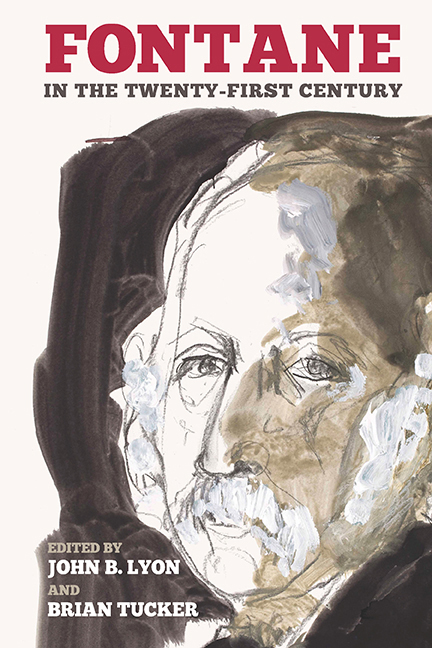Book contents
- Frontmatter
- Contents
- Acknowledgments
- Note on Editions
- Introduction: Fontane in the Twenty–First Century
- 1 Narrative Digression and the Transformation of Nationhood in Vor dem Sturm
- 2 Nasty Women: Female Anger as Moral Judgment in Grete Minde and Effi Briest
- 3 Performing the Philistine: Gossip as a Narrative Device and a Strategy for Reflection on Anti-Semitism in Theodor Fontane's L'Adultera
- 4 To Have an Eye: Visual Culture and the Misapprehension of Class in Irrungen, Wirrungen
- 5 Fontane as a Pacifist? The Antiwar Message in Quitt (1890) and Fontane's Changing Attitude to Militarism
- 6 Disjunctive Transnationalisms in Fontane's Frau Jenny Treibel
- 7 On the “Right Measure” in Effi Briest: Ethics and Aesthetics of the Prosaic
- 8 Transfiguration, Effect, and Engagement: Theodor Fontane's Aesthetic Thought
- 9 Fontane and World Literature: Prussians, Jews, and the Specter of Africa in Die Poggenpuhls
- 10 Von Zwanzig bis Dreißig: The Male Author in Parts
- 11 Melusine von Barby's Barriers and Connections in Fontane's Der Stechlin
- 12 Senescence and Fontane's Der Stechlin
- Notes on the Contributors
- Index
8 - Transfiguration, Effect, and Engagement: Theodor Fontane's Aesthetic Thought
Published online by Cambridge University Press: 31 August 2019
- Frontmatter
- Contents
- Acknowledgments
- Note on Editions
- Introduction: Fontane in the Twenty–First Century
- 1 Narrative Digression and the Transformation of Nationhood in Vor dem Sturm
- 2 Nasty Women: Female Anger as Moral Judgment in Grete Minde and Effi Briest
- 3 Performing the Philistine: Gossip as a Narrative Device and a Strategy for Reflection on Anti-Semitism in Theodor Fontane's L'Adultera
- 4 To Have an Eye: Visual Culture and the Misapprehension of Class in Irrungen, Wirrungen
- 5 Fontane as a Pacifist? The Antiwar Message in Quitt (1890) and Fontane's Changing Attitude to Militarism
- 6 Disjunctive Transnationalisms in Fontane's Frau Jenny Treibel
- 7 On the “Right Measure” in Effi Briest: Ethics and Aesthetics of the Prosaic
- 8 Transfiguration, Effect, and Engagement: Theodor Fontane's Aesthetic Thought
- 9 Fontane and World Literature: Prussians, Jews, and the Specter of Africa in Die Poggenpuhls
- 10 Von Zwanzig bis Dreißig: The Male Author in Parts
- 11 Melusine von Barby's Barriers and Connections in Fontane's Der Stechlin
- 12 Senescence and Fontane's Der Stechlin
- Notes on the Contributors
- Index
Summary
THE PURPOSE OF this essay is to shed light on Fontane's aesthetics by examining two related concepts that occur frequently both in the critical and the imaginative writings of Fontane: the idea of aesthetic effect, or Wirkung, and the idea of the interested subject, or engagement. Fontane's aesthetics is usually interpreted from the perspective of his early writing, especially his essay “Unsere lyrische und epische Poesie seit 1848” of 1853, in a way that suggests that Verklärung, or transfiguration, is the fundamental principle underpinning his critical thought. A broader survey of his oeuvre indicates that while Verklärung is an important principle for Fontane, it is not only an often imprecise and relative concept but is also subordinated to the primary aesthetic imperatives of effect and engagement. This is significant, in part because it suggests distance between the concerns of the mature critic Fontane and the discourses of programmatic realists in the middle of the century, but more so because while Verklärung can be seen as a conservative doctrine, seeking to preserve beauty in the face of modernity, Fontane's discussions of effect and engagement typically focus on art's need for relevance and contemporaneity. Not least, examining Fontane's discussions of effect and the response of the reader or spectator reveals that Fontane's reflections go beyond critical evaluations or theories of realism to encompass the interaction of the subject with the artwork in a progressive and fragile process of aesthetic experience. For Fontane, art must stimulate an immediate emotional response, something predicated upon the world represented in the artwork, but also upon the capability and predisposition of the perceiver.
The Opacities of Verklärung
Theodor Fontane's aesthetic thought has primarily been analyzed in terms of two related concepts, Realismus, or realism, and Verklärung, or transfiguration. In particular, Verklärung is often seen both as defining Fontane's understanding of art and realism and simultaneously as his own articulation of an aesthetic doctrine that divides German realism from other European realist writing of the age, a poetics that the term Verklärung has come to represent. Gerhard Plumpe's introduction to the standard Hanser Sozialgeschichte der deutschen Literatur (Social History of German Literature) can be taken as a representative example. He identifies Fontane as the source of the term Verklärung and summarizes his introduction to realist poetics by presenting the Verklärungsästhetik (aesthetics of transfiguration) as a consistent category of German realist aesthetics.
- Type
- Chapter
- Information
- Fontane in the Twenty-First Century , pp. 142 - 160Publisher: Boydell & BrewerPrint publication year: 2019

